Analyzing the Boeing 787 'Dreamliner' Supply Chain Model
VerifiedAdded on 2020/04/07
|6
|1967
|67
Essay
AI Summary
The essay delves into Boeing’s supply chain management challenges faced during the development of the Dreamliner, primarily focusing on issues like information exchange gaps among software manufacturers and lack of cross-functional communication. It recommends implementing a comprehensive enterprise resource planning (ERP) system to facilitate better integration across hardware, databases, and operating systems. This approach aims at enhancing real-time access to data about expected sales and inventory management. Furthermore, the essay suggests adopting business process reengineering for radical changes that empower individuals within Boeing, thereby addressing information exchange problems and reducing product development cycle times. The essay underscores that such strategic implementations could significantly mitigate supply chain issues, fostering a more streamlined and effective production process.

Running Head: CASE STUDY 1
Case Study
<Student ID>
<Student Name>
<University Name>
Case Study
<Student ID>
<Student Name>
<University Name>
Paraphrase This Document
Need a fresh take? Get an instant paraphrase of this document with our AI Paraphraser
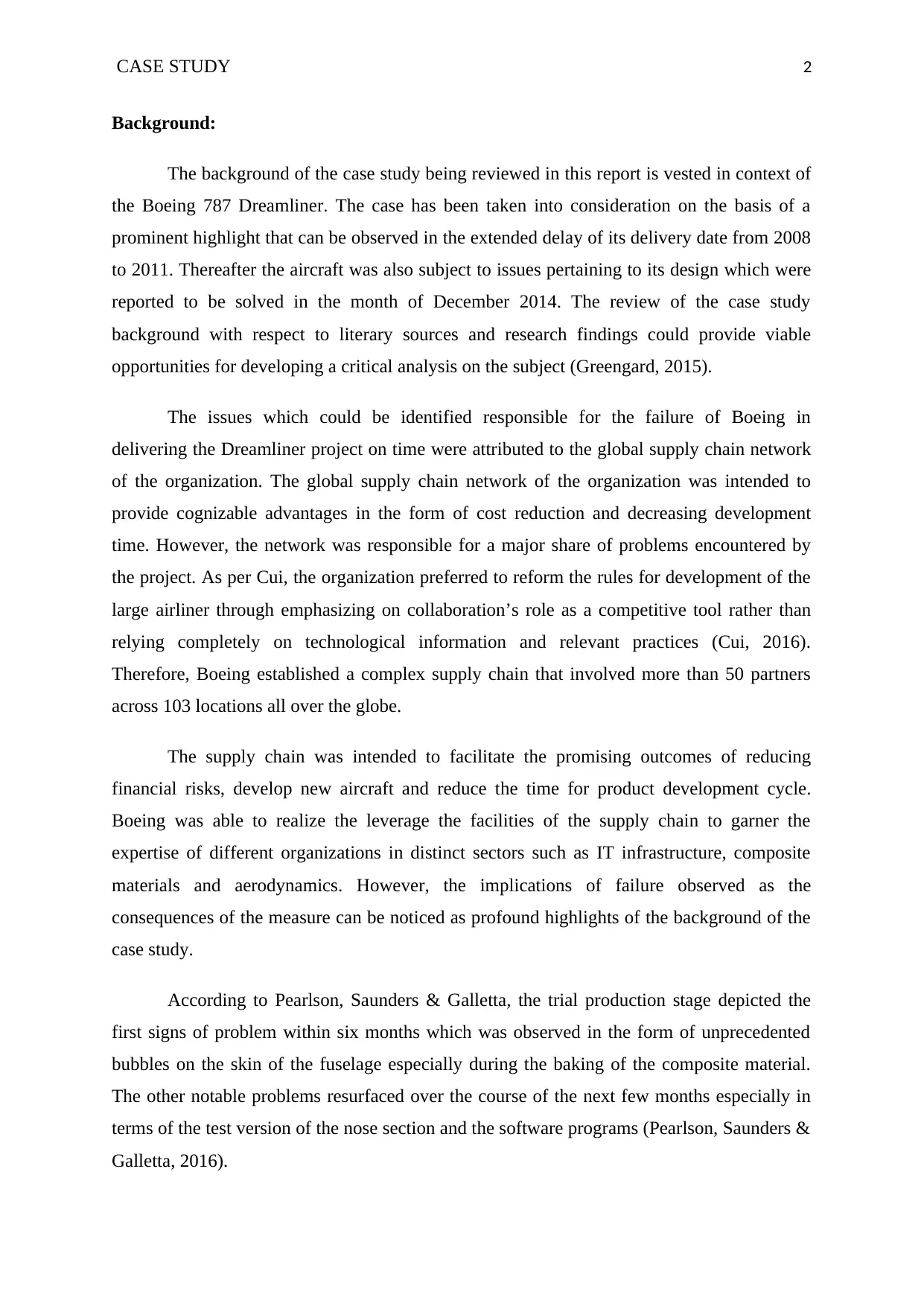
CASE STUDY 2
Background:
The background of the case study being reviewed in this report is vested in context of
the Boeing 787 Dreamliner. The case has been taken into consideration on the basis of a
prominent highlight that can be observed in the extended delay of its delivery date from 2008
to 2011. Thereafter the aircraft was also subject to issues pertaining to its design which were
reported to be solved in the month of December 2014. The review of the case study
background with respect to literary sources and research findings could provide viable
opportunities for developing a critical analysis on the subject (Greengard, 2015).
The issues which could be identified responsible for the failure of Boeing in
delivering the Dreamliner project on time were attributed to the global supply chain network
of the organization. The global supply chain network of the organization was intended to
provide cognizable advantages in the form of cost reduction and decreasing development
time. However, the network was responsible for a major share of problems encountered by
the project. As per Cui, the organization preferred to reform the rules for development of the
large airliner through emphasizing on collaboration’s role as a competitive tool rather than
relying completely on technological information and relevant practices (Cui, 2016).
Therefore, Boeing established a complex supply chain that involved more than 50 partners
across 103 locations all over the globe.
The supply chain was intended to facilitate the promising outcomes of reducing
financial risks, develop new aircraft and reduce the time for product development cycle.
Boeing was able to realize the leverage the facilities of the supply chain to garner the
expertise of different organizations in distinct sectors such as IT infrastructure, composite
materials and aerodynamics. However, the implications of failure observed as the
consequences of the measure can be noticed as profound highlights of the background of the
case study.
According to Pearlson, Saunders & Galletta, the trial production stage depicted the
first signs of problem within six months which was observed in the form of unprecedented
bubbles on the skin of the fuselage especially during the baking of the composite material.
The other notable problems resurfaced over the course of the next few months especially in
terms of the test version of the nose section and the software programs (Pearlson, Saunders &
Galletta, 2016).
Background:
The background of the case study being reviewed in this report is vested in context of
the Boeing 787 Dreamliner. The case has been taken into consideration on the basis of a
prominent highlight that can be observed in the extended delay of its delivery date from 2008
to 2011. Thereafter the aircraft was also subject to issues pertaining to its design which were
reported to be solved in the month of December 2014. The review of the case study
background with respect to literary sources and research findings could provide viable
opportunities for developing a critical analysis on the subject (Greengard, 2015).
The issues which could be identified responsible for the failure of Boeing in
delivering the Dreamliner project on time were attributed to the global supply chain network
of the organization. The global supply chain network of the organization was intended to
provide cognizable advantages in the form of cost reduction and decreasing development
time. However, the network was responsible for a major share of problems encountered by
the project. As per Cui, the organization preferred to reform the rules for development of the
large airliner through emphasizing on collaboration’s role as a competitive tool rather than
relying completely on technological information and relevant practices (Cui, 2016).
Therefore, Boeing established a complex supply chain that involved more than 50 partners
across 103 locations all over the globe.
The supply chain was intended to facilitate the promising outcomes of reducing
financial risks, develop new aircraft and reduce the time for product development cycle.
Boeing was able to realize the leverage the facilities of the supply chain to garner the
expertise of different organizations in distinct sectors such as IT infrastructure, composite
materials and aerodynamics. However, the implications of failure observed as the
consequences of the measure can be noticed as profound highlights of the background of the
case study.
According to Pearlson, Saunders & Galletta, the trial production stage depicted the
first signs of problem within six months which was observed in the form of unprecedented
bubbles on the skin of the fuselage especially during the baking of the composite material.
The other notable problems resurfaced over the course of the next few months especially in
terms of the test version of the nose section and the software programs (Pearlson, Saunders &
Galletta, 2016).
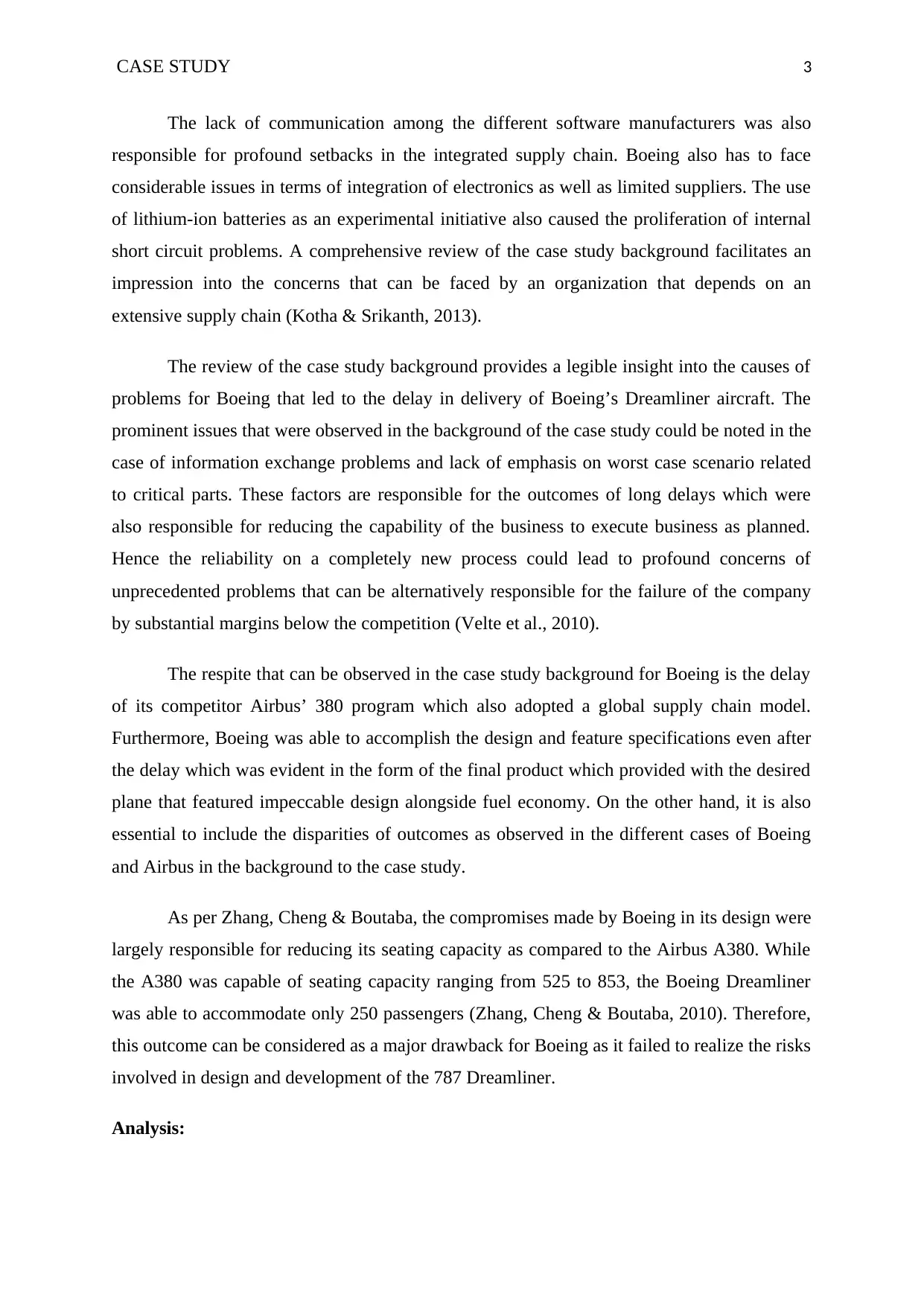
CASE STUDY 3
The lack of communication among the different software manufacturers was also
responsible for profound setbacks in the integrated supply chain. Boeing also has to face
considerable issues in terms of integration of electronics as well as limited suppliers. The use
of lithium-ion batteries as an experimental initiative also caused the proliferation of internal
short circuit problems. A comprehensive review of the case study background facilitates an
impression into the concerns that can be faced by an organization that depends on an
extensive supply chain (Kotha & Srikanth, 2013).
The review of the case study background provides a legible insight into the causes of
problems for Boeing that led to the delay in delivery of Boeing’s Dreamliner aircraft. The
prominent issues that were observed in the background of the case study could be noted in the
case of information exchange problems and lack of emphasis on worst case scenario related
to critical parts. These factors are responsible for the outcomes of long delays which were
also responsible for reducing the capability of the business to execute business as planned.
Hence the reliability on a completely new process could lead to profound concerns of
unprecedented problems that can be alternatively responsible for the failure of the company
by substantial margins below the competition (Velte et al., 2010).
The respite that can be observed in the case study background for Boeing is the delay
of its competitor Airbus’ 380 program which also adopted a global supply chain model.
Furthermore, Boeing was able to accomplish the design and feature specifications even after
the delay which was evident in the form of the final product which provided with the desired
plane that featured impeccable design alongside fuel economy. On the other hand, it is also
essential to include the disparities of outcomes as observed in the different cases of Boeing
and Airbus in the background to the case study.
As per Zhang, Cheng & Boutaba, the compromises made by Boeing in its design were
largely responsible for reducing its seating capacity as compared to the Airbus A380. While
the A380 was capable of seating capacity ranging from 525 to 853, the Boeing Dreamliner
was able to accommodate only 250 passengers (Zhang, Cheng & Boutaba, 2010). Therefore,
this outcome can be considered as a major drawback for Boeing as it failed to realize the risks
involved in design and development of the 787 Dreamliner.
Analysis:
The lack of communication among the different software manufacturers was also
responsible for profound setbacks in the integrated supply chain. Boeing also has to face
considerable issues in terms of integration of electronics as well as limited suppliers. The use
of lithium-ion batteries as an experimental initiative also caused the proliferation of internal
short circuit problems. A comprehensive review of the case study background facilitates an
impression into the concerns that can be faced by an organization that depends on an
extensive supply chain (Kotha & Srikanth, 2013).
The review of the case study background provides a legible insight into the causes of
problems for Boeing that led to the delay in delivery of Boeing’s Dreamliner aircraft. The
prominent issues that were observed in the background of the case study could be noted in the
case of information exchange problems and lack of emphasis on worst case scenario related
to critical parts. These factors are responsible for the outcomes of long delays which were
also responsible for reducing the capability of the business to execute business as planned.
Hence the reliability on a completely new process could lead to profound concerns of
unprecedented problems that can be alternatively responsible for the failure of the company
by substantial margins below the competition (Velte et al., 2010).
The respite that can be observed in the case study background for Boeing is the delay
of its competitor Airbus’ 380 program which also adopted a global supply chain model.
Furthermore, Boeing was able to accomplish the design and feature specifications even after
the delay which was evident in the form of the final product which provided with the desired
plane that featured impeccable design alongside fuel economy. On the other hand, it is also
essential to include the disparities of outcomes as observed in the different cases of Boeing
and Airbus in the background to the case study.
As per Zhang, Cheng & Boutaba, the compromises made by Boeing in its design were
largely responsible for reducing its seating capacity as compared to the Airbus A380. While
the A380 was capable of seating capacity ranging from 525 to 853, the Boeing Dreamliner
was able to accommodate only 250 passengers (Zhang, Cheng & Boutaba, 2010). Therefore,
this outcome can be considered as a major drawback for Boeing as it failed to realize the risks
involved in design and development of the 787 Dreamliner.
Analysis:
⊘ This is a preview!⊘
Do you want full access?
Subscribe today to unlock all pages.

Trusted by 1+ million students worldwide
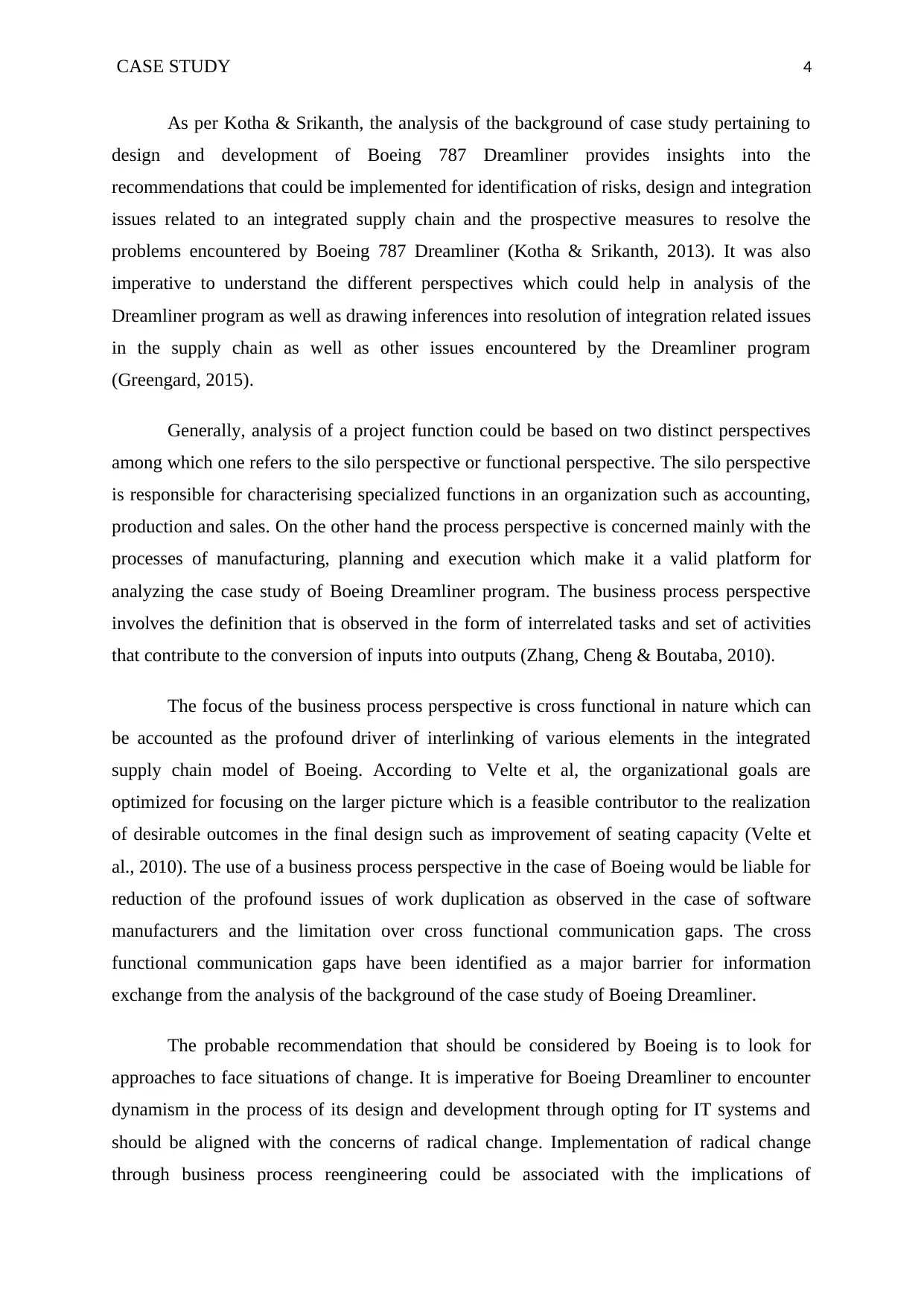
CASE STUDY 4
As per Kotha & Srikanth, the analysis of the background of case study pertaining to
design and development of Boeing 787 Dreamliner provides insights into the
recommendations that could be implemented for identification of risks, design and integration
issues related to an integrated supply chain and the prospective measures to resolve the
problems encountered by Boeing 787 Dreamliner (Kotha & Srikanth, 2013). It was also
imperative to understand the different perspectives which could help in analysis of the
Dreamliner program as well as drawing inferences into resolution of integration related issues
in the supply chain as well as other issues encountered by the Dreamliner program
(Greengard, 2015).
Generally, analysis of a project function could be based on two distinct perspectives
among which one refers to the silo perspective or functional perspective. The silo perspective
is responsible for characterising specialized functions in an organization such as accounting,
production and sales. On the other hand the process perspective is concerned mainly with the
processes of manufacturing, planning and execution which make it a valid platform for
analyzing the case study of Boeing Dreamliner program. The business process perspective
involves the definition that is observed in the form of interrelated tasks and set of activities
that contribute to the conversion of inputs into outputs (Zhang, Cheng & Boutaba, 2010).
The focus of the business process perspective is cross functional in nature which can
be accounted as the profound driver of interlinking of various elements in the integrated
supply chain model of Boeing. According to Velte et al, the organizational goals are
optimized for focusing on the larger picture which is a feasible contributor to the realization
of desirable outcomes in the final design such as improvement of seating capacity (Velte et
al., 2010). The use of a business process perspective in the case of Boeing would be liable for
reduction of the profound issues of work duplication as observed in the case of software
manufacturers and the limitation over cross functional communication gaps. The cross
functional communication gaps have been identified as a major barrier for information
exchange from the analysis of the background of the case study of Boeing Dreamliner.
The probable recommendation that should be considered by Boeing is to look for
approaches to face situations of change. It is imperative for Boeing Dreamliner to encounter
dynamism in the process of its design and development through opting for IT systems and
should be aligned with the concerns of radical change. Implementation of radical change
through business process reengineering could be associated with the implications of
As per Kotha & Srikanth, the analysis of the background of case study pertaining to
design and development of Boeing 787 Dreamliner provides insights into the
recommendations that could be implemented for identification of risks, design and integration
issues related to an integrated supply chain and the prospective measures to resolve the
problems encountered by Boeing 787 Dreamliner (Kotha & Srikanth, 2013). It was also
imperative to understand the different perspectives which could help in analysis of the
Dreamliner program as well as drawing inferences into resolution of integration related issues
in the supply chain as well as other issues encountered by the Dreamliner program
(Greengard, 2015).
Generally, analysis of a project function could be based on two distinct perspectives
among which one refers to the silo perspective or functional perspective. The silo perspective
is responsible for characterising specialized functions in an organization such as accounting,
production and sales. On the other hand the process perspective is concerned mainly with the
processes of manufacturing, planning and execution which make it a valid platform for
analyzing the case study of Boeing Dreamliner program. The business process perspective
involves the definition that is observed in the form of interrelated tasks and set of activities
that contribute to the conversion of inputs into outputs (Zhang, Cheng & Boutaba, 2010).
The focus of the business process perspective is cross functional in nature which can
be accounted as the profound driver of interlinking of various elements in the integrated
supply chain model of Boeing. According to Velte et al, the organizational goals are
optimized for focusing on the larger picture which is a feasible contributor to the realization
of desirable outcomes in the final design such as improvement of seating capacity (Velte et
al., 2010). The use of a business process perspective in the case of Boeing would be liable for
reduction of the profound issues of work duplication as observed in the case of software
manufacturers and the limitation over cross functional communication gaps. The cross
functional communication gaps have been identified as a major barrier for information
exchange from the analysis of the background of the case study of Boeing Dreamliner.
The probable recommendation that should be considered by Boeing is to look for
approaches to face situations of change. It is imperative for Boeing Dreamliner to encounter
dynamism in the process of its design and development through opting for IT systems and
should be aligned with the concerns of radical change. Implementation of radical change
through business process reengineering could be associated with the implications of
Paraphrase This Document
Need a fresh take? Get an instant paraphrase of this document with our AI Paraphraser
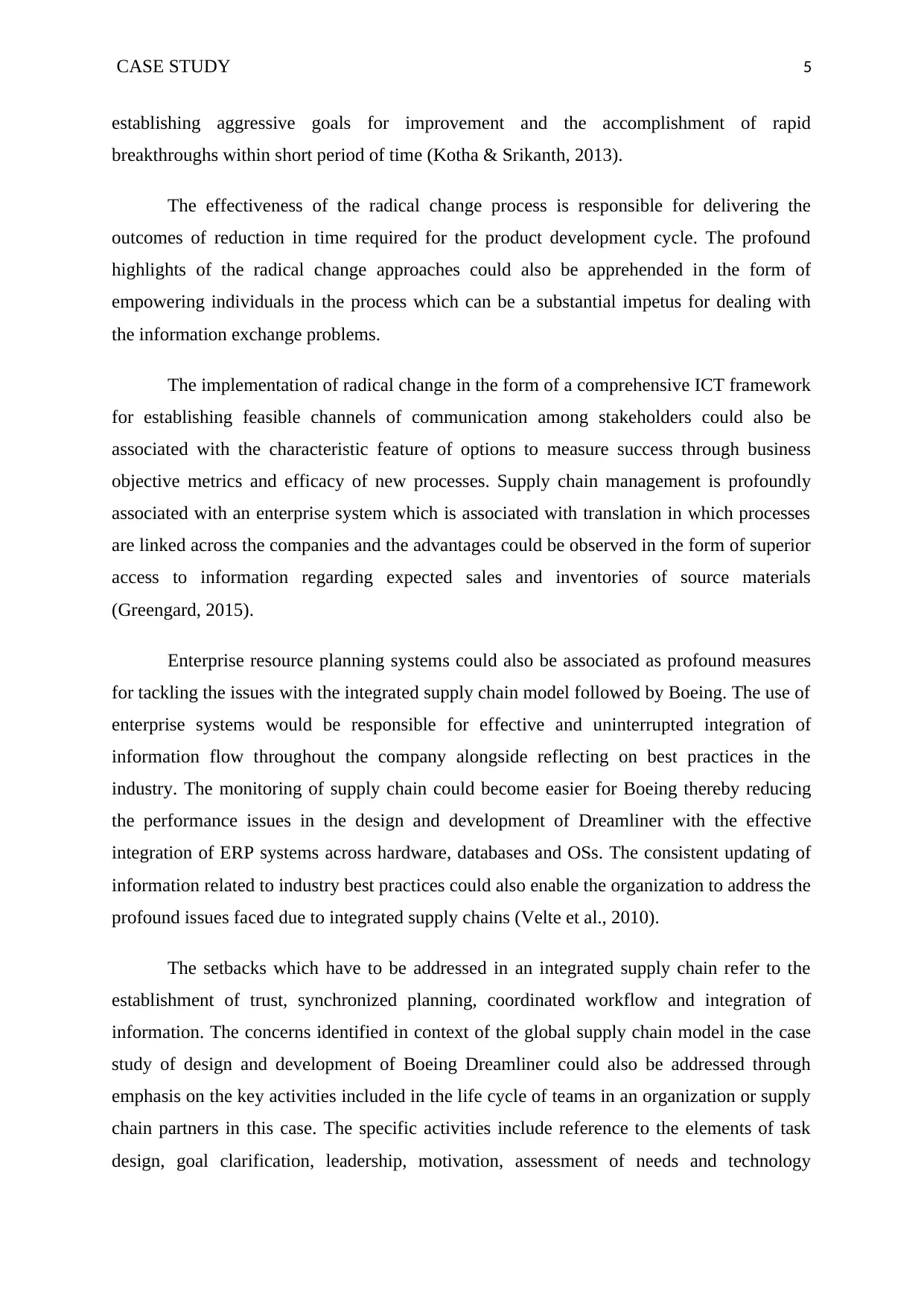
CASE STUDY 5
establishing aggressive goals for improvement and the accomplishment of rapid
breakthroughs within short period of time (Kotha & Srikanth, 2013).
The effectiveness of the radical change process is responsible for delivering the
outcomes of reduction in time required for the product development cycle. The profound
highlights of the radical change approaches could also be apprehended in the form of
empowering individuals in the process which can be a substantial impetus for dealing with
the information exchange problems.
The implementation of radical change in the form of a comprehensive ICT framework
for establishing feasible channels of communication among stakeholders could also be
associated with the characteristic feature of options to measure success through business
objective metrics and efficacy of new processes. Supply chain management is profoundly
associated with an enterprise system which is associated with translation in which processes
are linked across the companies and the advantages could be observed in the form of superior
access to information regarding expected sales and inventories of source materials
(Greengard, 2015).
Enterprise resource planning systems could also be associated as profound measures
for tackling the issues with the integrated supply chain model followed by Boeing. The use of
enterprise systems would be responsible for effective and uninterrupted integration of
information flow throughout the company alongside reflecting on best practices in the
industry. The monitoring of supply chain could become easier for Boeing thereby reducing
the performance issues in the design and development of Dreamliner with the effective
integration of ERP systems across hardware, databases and OSs. The consistent updating of
information related to industry best practices could also enable the organization to address the
profound issues faced due to integrated supply chains (Velte et al., 2010).
The setbacks which have to be addressed in an integrated supply chain refer to the
establishment of trust, synchronized planning, coordinated workflow and integration of
information. The concerns identified in context of the global supply chain model in the case
study of design and development of Boeing Dreamliner could also be addressed through
emphasis on the key activities included in the life cycle of teams in an organization or supply
chain partners in this case. The specific activities include reference to the elements of task
design, goal clarification, leadership, motivation, assessment of needs and technology
establishing aggressive goals for improvement and the accomplishment of rapid
breakthroughs within short period of time (Kotha & Srikanth, 2013).
The effectiveness of the radical change process is responsible for delivering the
outcomes of reduction in time required for the product development cycle. The profound
highlights of the radical change approaches could also be apprehended in the form of
empowering individuals in the process which can be a substantial impetus for dealing with
the information exchange problems.
The implementation of radical change in the form of a comprehensive ICT framework
for establishing feasible channels of communication among stakeholders could also be
associated with the characteristic feature of options to measure success through business
objective metrics and efficacy of new processes. Supply chain management is profoundly
associated with an enterprise system which is associated with translation in which processes
are linked across the companies and the advantages could be observed in the form of superior
access to information regarding expected sales and inventories of source materials
(Greengard, 2015).
Enterprise resource planning systems could also be associated as profound measures
for tackling the issues with the integrated supply chain model followed by Boeing. The use of
enterprise systems would be responsible for effective and uninterrupted integration of
information flow throughout the company alongside reflecting on best practices in the
industry. The monitoring of supply chain could become easier for Boeing thereby reducing
the performance issues in the design and development of Dreamliner with the effective
integration of ERP systems across hardware, databases and OSs. The consistent updating of
information related to industry best practices could also enable the organization to address the
profound issues faced due to integrated supply chains (Velte et al., 2010).
The setbacks which have to be addressed in an integrated supply chain refer to the
establishment of trust, synchronized planning, coordinated workflow and integration of
information. The concerns identified in context of the global supply chain model in the case
study of design and development of Boeing Dreamliner could also be addressed through
emphasis on the key activities included in the life cycle of teams in an organization or supply
chain partners in this case. The specific activities include reference to the elements of task
design, goal clarification, leadership, motivation, assessment of needs and technology
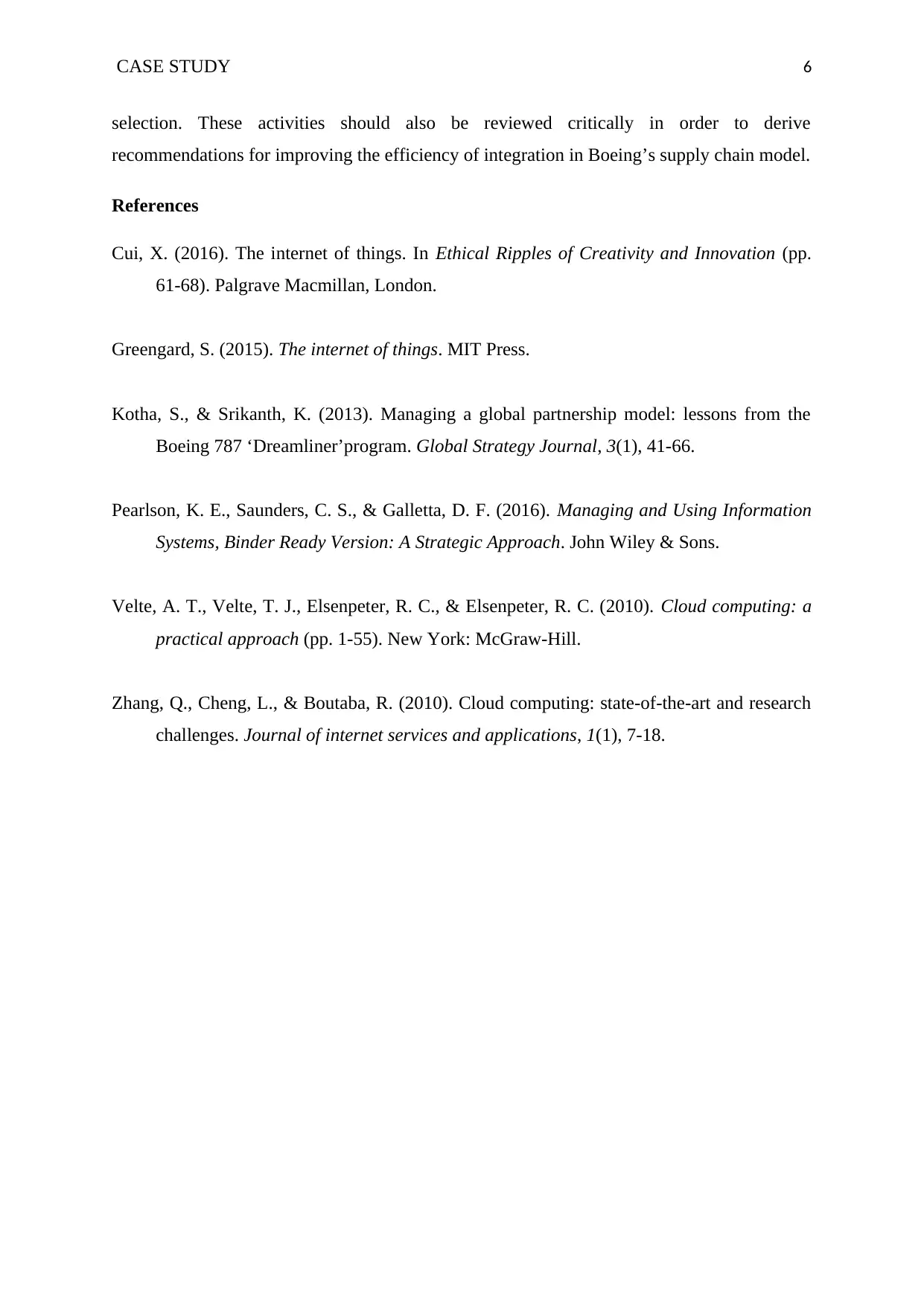
CASE STUDY 6
selection. These activities should also be reviewed critically in order to derive
recommendations for improving the efficiency of integration in Boeing’s supply chain model.
References
Cui, X. (2016). The internet of things. In Ethical Ripples of Creativity and Innovation (pp.
61-68). Palgrave Macmillan, London.
Greengard, S. (2015). The internet of things. MIT Press.
Kotha, S., & Srikanth, K. (2013). Managing a global partnership model: lessons from the
Boeing 787 ‘Dreamliner’program. Global Strategy Journal, 3(1), 41-66.
Pearlson, K. E., Saunders, C. S., & Galletta, D. F. (2016). Managing and Using Information
Systems, Binder Ready Version: A Strategic Approach. John Wiley & Sons.
Velte, A. T., Velte, T. J., Elsenpeter, R. C., & Elsenpeter, R. C. (2010). Cloud computing: a
practical approach (pp. 1-55). New York: McGraw-Hill.
Zhang, Q., Cheng, L., & Boutaba, R. (2010). Cloud computing: state-of-the-art and research
challenges. Journal of internet services and applications, 1(1), 7-18.
selection. These activities should also be reviewed critically in order to derive
recommendations for improving the efficiency of integration in Boeing’s supply chain model.
References
Cui, X. (2016). The internet of things. In Ethical Ripples of Creativity and Innovation (pp.
61-68). Palgrave Macmillan, London.
Greengard, S. (2015). The internet of things. MIT Press.
Kotha, S., & Srikanth, K. (2013). Managing a global partnership model: lessons from the
Boeing 787 ‘Dreamliner’program. Global Strategy Journal, 3(1), 41-66.
Pearlson, K. E., Saunders, C. S., & Galletta, D. F. (2016). Managing and Using Information
Systems, Binder Ready Version: A Strategic Approach. John Wiley & Sons.
Velte, A. T., Velte, T. J., Elsenpeter, R. C., & Elsenpeter, R. C. (2010). Cloud computing: a
practical approach (pp. 1-55). New York: McGraw-Hill.
Zhang, Q., Cheng, L., & Boutaba, R. (2010). Cloud computing: state-of-the-art and research
challenges. Journal of internet services and applications, 1(1), 7-18.
⊘ This is a preview!⊘
Do you want full access?
Subscribe today to unlock all pages.

Trusted by 1+ million students worldwide
1 out of 6
Your All-in-One AI-Powered Toolkit for Academic Success.
+13062052269
info@desklib.com
Available 24*7 on WhatsApp / Email
![[object Object]](/_next/static/media/star-bottom.7253800d.svg)
Unlock your academic potential
Copyright © 2020–2025 A2Z Services. All Rights Reserved. Developed and managed by ZUCOL.